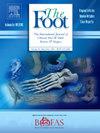Patient and treatment related factors associated with prolonged opioid use following foot and ankle surgery: A scoping review
Q2 Health Professions
引用次数: 0
Abstract
Background
The need for adequate analgesia postoperatively must be balanced against the risks of excessive or prolonged opioid use. This scoping review aims to identify the most common risk factors for prolonged or increased opioid use following foot and ankle surgery.
Methods
A scoping review was performed according to the PRISMA guidelines. An electronic literature search was performed in PubMed, Web of Science, Embase and CINAHL. Two reviewers independently performed title/abstract and full-text screening. English language articles describing preoperative patient or treatment related factors associated with an increased risk of prolonged opioid use or increased long-term opioid dosage were included.
Results
A total of 17 studies describing 223,532 patients undergoing foot and ankle surgery were included. The most commonly reported factors associated with a higher risk of prolonged or increased use of opioids were: preoperative opioid use (13 studies), mental health disorders (9 studies), tobacco use (7 studies), chronic pain disorders (7 studies), female sex (7 studies), older age (5 studies) and diabetes (4 studies). A similar distribution of risk factors was found in studies using multivariate statistical techniques to identify independent risk factors specifically.
Conclusions
Preoperative opioid use, mental health disorders, tobacco use, chronic pain disorders, female sex and older age are the most frequently reported risk factors for increased opioid use following foot and ankle surgery. These factors can be used to guide clinical decision making with regards to surgical selection criteria and in the development of targeted interventions aimed at reducing unnecessary or excessive opioid use.
足部和踝关节手术后延长阿片类药物使用的患者和治疗相关因素:范围审查
背景:术后充分镇痛的需要必须与过量或长时间使用阿片类药物的风险相平衡。本综述旨在确定足部和踝关节手术后延长或增加阿片类药物使用的最常见危险因素。方法根据PRISMA指南进行范围审查。在PubMed、Web of Science、Embase和CINAHL进行电子文献检索。两位审稿人独立进行标题/摘要和全文筛选。纳入描述术前患者或治疗相关因素与阿片类药物长期使用风险增加或长期阿片类药物剂量增加相关的英文文章。结果共纳入17项研究,共涉及223,532例足部和踝关节手术患者。与延长或增加阿片类药物使用风险较高相关的最常见报告因素是:术前阿片类药物使用(13项研究)、精神健康障碍(9项研究)、烟草使用(7项研究)、慢性疼痛障碍(7项研究)、女性(7项研究)、年龄较大(5项研究)和糖尿病(4项研究)。在使用多变量统计技术专门确定独立风险因素的研究中发现了类似的风险因素分布。结论术前阿片类药物使用、精神健康障碍、烟草使用、慢性疼痛障碍、女性和年龄是足踝手术后阿片类药物使用增加的最常见危险因素。这些因素可用于指导有关手术选择标准的临床决策,并用于制定旨在减少不必要或过度使用阿片类药物的有针对性的干预措施。
本文章由计算机程序翻译,如有差异,请以英文原文为准。
求助全文
约1分钟内获得全文
求助全文
来源期刊

Foot
Health Professions-Podiatry
CiteScore
2.00
自引率
0.00%
发文量
37
期刊介绍:
The Foot is an international peer-reviewed journal covering all aspects of scientific approaches and medical and surgical treatment of the foot. The Foot aims to provide a multidisciplinary platform for all specialties involved in treating disorders of the foot. At present it is the only journal which provides this inter-disciplinary opportunity. Primary research papers cover a wide range of disorders of the foot and their treatment, including diabetes, vascular disease, neurological, dermatological and infectious conditions, sports injuries, biomechanics, bioengineering, orthoses and prostheses.
 求助内容:
求助内容: 应助结果提醒方式:
应助结果提醒方式:


